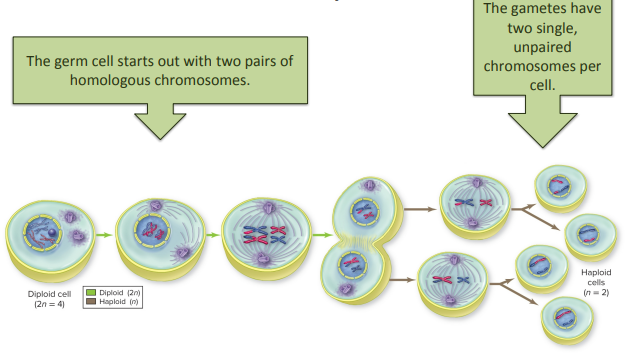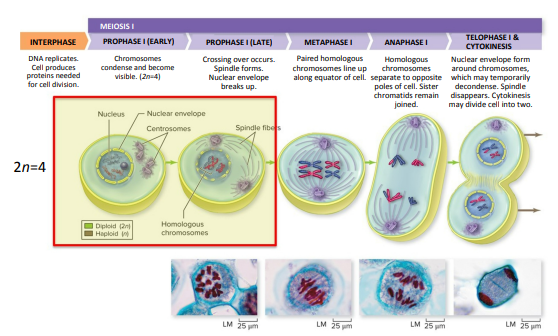Chapter 9 - Sexual Reproduction and Meiosis
Reproduction can be asexual
In asexual reproduction, one parent organism replicates its DNA and splits the contents of one cell into two. Asexual reproduction generates genetically identical offspring.
Asexual reproduction is relatively rare
Single - celled organisms such as bacteria, archaea, and protists reproduce asexually, but among multicellular organisms it is not very common.
Reproduction can be sexual
In sexual reproduction, the DNA of the offspring comes from two parents. An egg fuses with a sperm, yielding the first cell of the next generation.
Sexual reproduction generates genetically diverse offspring.
Humans, dogs, and many other familiar organisms reproduce sexually.
Why sex?
Attracting a mate and producing sex cells requires a lot of energy, which is costly to the organism. Why is sexual reproduction so common?
Genetic diversity is worth it
Sexual reproduction produces genetic diversity among offspring, which increases the chance that some offspring survive in changing environments

Diploid cells contain two sets of chromosomes
Most cells in a sexually reproducing organism have two sets of chromosomes: one from the father and one from the mother.
Cells with two sets of chromosomes are called diploid cells
Human cells contain 23 homologous sets of chromosomes
The image below is called a karyotype . It shows all of the chromosomes from a diploid human cell

Human cells contain 22 homologous sets of autosomes
The numbered chromosomes are called autosomes. These chromosomes are the same for both males and females.
Notice that each autosome pair consists of two equally - sized chromosomes.
Human cells contain one set of sex chromosomes
The chromosomes denoted by letter are the sex chromosomes.
In humans, an individual with two X chromosomes is female, and an individual with one X and one Y chromosome is male.

Homologous sets of chromosomes carry the same sets of genes
The chromosomes of a homologous pair are similar in size and structure.
The DNA sequence is not the same, but each chromosome in a homologous pair has genes for the same traits.
Homologous sets of chromosomes are not identical
The members of a homologous pair may carry different alleles, which are alternative versions of the same gene.
Notice the two different alleles for Gene B, although the alleles for Genes A and C are the same.

Gametes are produced by meiosis
Gametes, like the sperm and egg cells in this image, are haploid sex cells.
A haploid cell has only one set of chromosomes.
Gamete fusion creates a new organism
When two haploid sex cells fuse at fertilization, one diploid zygotes is formed.
A zygote is the first cell of a new organism.
Zygotes grow and develop by mitosis
A zygote divides by mitosis to build an organism with trillions of identical cells

Meiosis is essential in sexual reproduction
In adults, specialized diploid cells called germ cells divide by meiosis to form haploid gametes.

Meiosis overview
Meiosis halves the chromosome number and scramble the alleles. Four genetically distinct gametes are produced

In meiosis, DNA replicates once, but the nucleus divides twice
This summary figure shows the nucleus dividing twice.

Meiosis reduces the number of chromosomes by half

Prophase 1: Homologous chromosomes pair up and attach to the spindle

Metaphase 1: Homologous chromosomes line up in two rows

Anaphase 1: Homologous chromosomes separate

Telophase 1: Chromatids remain together

Prophase 2: Chromosomes attach to spindle

Metaphase 2: Chromosomes line up in one row

Anaphase 2: Chromatids separate

Telophase 2: Four new cells each have one set of chromosomes

Meiosis generates genetic variability
The chromosomes in the gametes produced during meiosis are different from one another because of:
- crossing over (prophase 1)
- independent assortment (metaphase 1)
Crossing over occurs in meiosis prophase 1
During crossing over two homologous chromosomes pair up and exchange pieces, scrambling the genetic material

Independent assortment occurs in meiosis in metaphase 1
In independent assortment, chromosome pairs align randomly, scrambling the combination of chromosomes for each gamete
Independent assortment produces many chromosome combinations
A germ cell with three pairs of chromosomes has four possible arrangements during metaphase , yielding eight possible gametes (2^3 = 8)

Monozygotic twins are genetically identical
Sometimes, in early development, an embryo splits in two. Each embryo then develops independently.

Dizygotic twins have unique DNA
Fraternal twins are a testament to the variation among gametes; two sperm cells fertilize two separate egg cells, and the offspring might look very different

Mitosis and meiosis are different

Errors sometimes can occur in meiosis
If chromosomes fail to separate properly, abnormal gametes form. This failure to separate is called nondisjunction
Nondisjunction can occur in anaphase 1

Nondisjunction can occur in anaphase 2

Long description: A germ cell undergoes meiosis with nondisjunction in anaphase 2; formation of gametes and zygotes with abnormal and normal chromosome number are shown.
Nondisjunction can be lethal

Long description: A germ cell is shown undergoing meiosis with nondisjunction in anaphase 2; formation of gametes and zygotes with abnormal and normal chromosome number are shown.
Down syndrome is caused by nondisjunction
An extra copy of a chromosome - a trisomy - causes genetic disorders such as Down syndrome.
Down syndrome individuals have three copies of chromosome #21 rather than two.

Nondisjunction of sex chromosomes causes sex disorders

Errors can also occur within chromosomes
Mutations in chromosome structure can have major effects on an organism

Meiosis produces human gametes
Germ cells located in the testes give rise to sperm cells. Germ cells located in the ovaries give rise to egg cells.
Spermatogenesis produces four sperm cells for each germ cell

Oogenesis produces one egg cell for each germ cell

Meiosis produces spores
Fungi, some protists, and certain plants produce haploid spores.
The spores undergo mitosis to form haploid gametophytes that produce sperm and eggs.

Investigation life:
Evolving parasites select for sex in worms
Why do animals spend so much energy sexually reproducing?
Studying a worm that can preproduce either sexually or asexually might help answer this question.

Bacteria can impact worm reproduction
Exposure to evolving populations of parasites such as bacteria favors sexual reproduction in the worms
Exposure to no evolving bacteria favors asexual reproduction in the worms

Asexual reproduction is not enough
Worms that only reproduce asexually could not survive with the evolving bacteria.
Sexual reproduction, and therefore meiosis, increased their evolutionary fitness (the ability to survive and reproduce) when faces with a rapidly evolving parasite population
